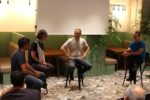The 2025 Design and Verification Conference (DVCon) was a four-day event packed with insightful discussions, cutting-edge technology showcases, and thought-provoking debates. The conference agenda included a rich mix of tutorial sessions, a keynote presentation, a panel discussion, and an exhibit hall with Electronic… Read More
Tag: moshe zalcberg
Weebit Nano at the 2024 Design Automation Conference
Innovative Memory Architectures for AI – Don’t Miss this DAC Session!
We all know that the proliferation of AI applications is happening at an unprecedented rate while at the same time, memories aren’t scaling along with logic. This is one of many reasons that the industry is exploring new memory technologies and architectures.… Read More
Python in Verification. Veriest MeetUp
Veriest held a recent meetup on a topic that has always made me curious – use of Python in verification. The event, moderated by Dusica Glisic (technical marketing manager at Veriest), started with an intro from Moshe Zalcberg (CEO of Veriest) and talks by Avidan Efody (Apple verification) and Tamás Kállay (Team leader, Veriest).… Read More
On Standards and Open-Sourcing. Verification Talks
At Veriest we host VERIFICATION MEETUPS periodically to share verification wisdom. In our virtual meetings we’ve had hundreds of attendants from the US, Europe, Israel, India, and China. Most recently we were able to host a live event in Israel – I want to share feedback from that meeting.
We started with two presentations:… Read More
Veriest Meetup Provides Insights on Safety, Deadlocks
I wasn’t familiar with Veriest, I’m guessing you may not be either. They are a design and verification services company based in the Tel Aviv area (Israel). The CEO, Moshe Zalcberg, was earlier GM for Cadence in Israel. Echoes for me of the early days working with Ajoy Bose in Interra. Veriest have a big emphasis in verification, for… Read More
UBER car accident: Verifying more of the same versus the long-tail cases
The recent fatal accident involving an UBER autonomous car, was reportedly not caused – as initially assumed – by a failure of the many sensors on the car to recognize the cyclist. It was instead caused by a failure of the software to take the right decision in regard to that “object”. The system apparently… Read More






